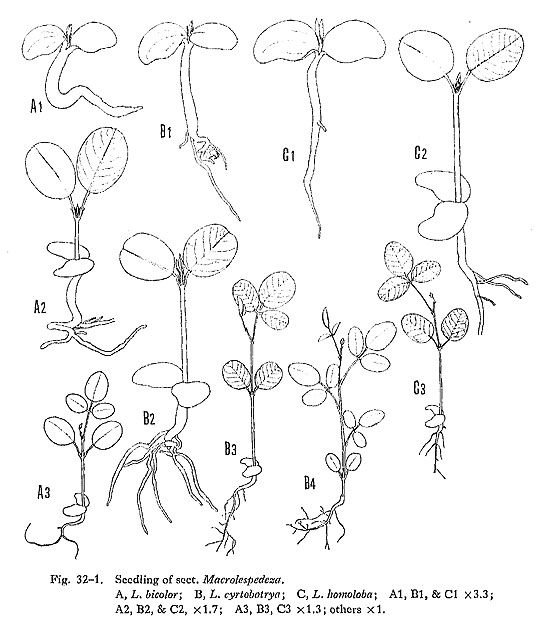Morphological Diversity and Variation
Seedlings
|
De Candolle (1825) made the first major survey of seedlings of the Leguminosae. He divided the greater part of the Papilionoideae into two, those with foliar cotyledons (phyllolobées) and those with storage cotyledons (sarcolobées). That classification was superseded by the system of Bentham (1865). In the Leguminosae the forms of seedlings of many species have been observed and described by various botanists (cf. Duke & Polhill, 1981). The seedlings of some species of Lespedeza were described briefly by de Candolle (1825). Vassilczenko (1937) reported the seedling morphology of L. angustifolia Ell. of sect. Lespedeza. In the present study the seedlings of the following species were observed in the Botanical Gardens, the University of Tokyo: L. bicolor, L. cyrtobotrya, L. homoloba, L. formosa subsp. velutina, L. patens, and L. Buergeri, in sect. Macrolespedeza; and L. cuneata, L, inschanica, L. juncea, L. pilosa, L. tomentosa, and L. daurica in sect. Lespedeza. In all species of sect. Macrolespedeza so far examined, when the seed germinates, the primary root sprouts both seed coat and pericarp. After the primary root has elongated, the hypocotyle elongates orthotropously. The cotyledons arc epigeous, exstipulate, asymmetrical, reniform with dense hairs on both surfaces and, have reticulated venation with a primary vein accompanied by a pair of lateral veinlets (Fig. 32). The shape of cotyledons is scarcely distinguishable among different species. The cotyledons, which are thick, colorless, and store nutrients before germination commences, become green as photosynthetic organs. As soon as the cotyledons expand, the initial stem appears and the first two opposite eophylls develop decussately (Fig. 32 A2, B2, C2, C2, E2). The first two eophylls are always unifoliolate, entire, with a pair of stipules and have approximately six to ten lateral veinlets, which do not reach the margins. The upper portion of the hypocotyl has dense to sparse hairs. The third leaf is trifoliolate with a pair of stipules like the adult leaves (metaphylls) (Fig. 32 A3, B3, C3, D3, E3). From the third leaf, the phyllotaxy changes from opposite to spiral in divergence. There is no specific difference in seedling morphology and germination pattern in sect. Macrolespedeza. Even in L. Buergeri (Fig. 32E) the phyllotaxy in the seedling stage is spiral, although the phyllotaxy is distichous in the adult stage.
In the section Lespedeza more diversification in seedling morphology was observed. L. cuneata, its allies (L. juncea and L. inschanica), and L. virgata have seedlings like those of species of sect. Macrolespedeza. In L. pilosa and L. tomentosa the third leaf is unifoliolate. The seedling bears a few unifoliolate and sometimes bifoliolate leaves, and then trifoliolate leaves grow. |

